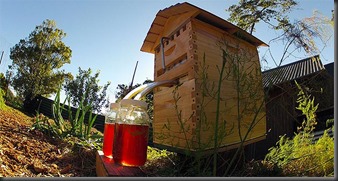 You know you love it: that smooth amber flow of rich nutritious sweetness, that distinct rich flavour, that gorgeous natural bronze hue. You put it on your cereal, in your tea, in your coffee, you drizzle it on hot rolls, sweet buns, your lover. You know what I’m talking about: Honey! In the ancient fertile crescent of civilization, before high-fructose corn syrup, refined cane or beet sugar, even maple syrup, there was honey. It was mixed with wine to create a sweet and savoury beverage by the Greeks, so celebrated by Homer. Honey is a nutritious source of energy, with trace B-vitamins and just a hint of hydrogen peroxide which makes it naturally antiseptic and resistant to spoilage.
You know you love it: that smooth amber flow of rich nutritious sweetness, that distinct rich flavour, that gorgeous natural bronze hue. You put it on your cereal, in your tea, in your coffee, you drizzle it on hot rolls, sweet buns, your lover. You know what I’m talking about: Honey! In the ancient fertile crescent of civilization, before high-fructose corn syrup, refined cane or beet sugar, even maple syrup, there was honey. It was mixed with wine to create a sweet and savoury beverage by the Greeks, so celebrated by Homer. Honey is a nutritious source of energy, with trace B-vitamins and just a hint of hydrogen peroxide which makes it naturally antiseptic and resistant to spoilage.
But Honey might not be long for our cupboards and dinner rolls. Honey is only produced by one genus of animal on this planet: Bees. And bees are dying. Not only will we need to learn to suffice with honey flavoured corn syrup on our KFC biscuits (Curse you Colonel!) but our crops will lose the ability to have sex. Bees are a crucial organ of pollen transport for plants, especially the flowering ones that produce our fruits and grains. Our food supply will rely on artificial pollination methods which are expensive and not always effective. And if our agriculture must rely on artificial pollinators, what about the rest of nature? Plants will adapt, to be sure, and while green will remain one of the hues of the earth, flowers may become a scarce commodity, no longer a suitable strategy for seed propagation. Animals that rely on honey as a food source will need to search for other sources of energy. Honey Badger may not care now, but when the bees are gone, well, what will he do with himself!
While there will be solutions to the pollinator problem, the best solution to any problem is always prevention. We see the populations declining, some causes have been pointed out but there is still so much we simply don’t know. While the engine of research trundles along in search of answers, the rest of us can do our part to preserve the pollinators. It’s easy to talk about the decline of the bee population with angry shouts of “We need to make changes! We need to do something about this!”, but in the end we look at the problem in defeat, not knowing what to do, or how to do it. Now, with the new Flow Hive beehive kit, you can really put your honey where your mouth is, and become a protector of the pollinators, a champion of crops and wildflowers everywhere, a humble keeper of bees.
The Flow Hive is pretty awesome. You get the whole kit-and-kaboodle for under $300 bucks, just add bees. Now, like any living creature, you really ought to do some research into how to handle and care for the little critters, but the Flow Hive makes it easy and safe to setup your hive and harvest the honey after a few weeks without destroying the hive. The specialized frames allow the bees to store their honey, wax up the holes, and then with the nifty little tool, you just crank out the honey and let it flow out into your container of choice. Viola! Pure, raw, delicious honey! Now, you need an open area, and you need flowers, so you probably won’t have much success on the porch of your studio apartment in the Bronx, but if you’d got the space, and the means, then you’re virtually obligated to setup a hive or three FOR THE FUTURE OF HUMANKIND!!! No pressure.
The Flow Hive flow frames replace traditional honeycomb frames and reduce the need for the bees to build each comb from scratch. Bees will use 2 pounds of honey just to make 1 pound of wax, so saving them the trouble puts more honey in your pot. Plus, you don’t have to go through the trouble of taking apart the honeycomb to get at the honey, which saves both you and the bees some aggravation.
by Taboola | (Source: offgridworld.com; February 25, 2015; http://tinyurl.com/ozwwcdj)
